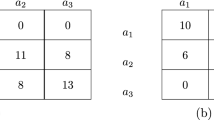Abstract
The maximum number of edge-disjoint spanning trees in a network has been used as a measure of the strength of a network. It gives the number of disjoint ways that the network can be fully connected. This suggests a game theoretic analysis that shows the relative importance of the different links to form a strong network. We introduce the Network strength game as a cooperative game defined on a graph \(G=(V,E)\). The player set is the edge-set E and the value of a coalition \(S \subseteq E\) is the maximum number of disjoint spanning trees included in S. We study the core of this game, and we give a polynomial combinatorial algorithm to compute the nucleolus when the core is non-empty.








Similar content being viewed by others
References
Aziz, H., Lachish, O., Paterson, M., Savani, R.: Wiretapping a hidden network. In: Leonardi, S. (ed.) Internet and Network Economics, pp. 438–446. Springer (2009)
Aziz, H., Lachish, O., Paterson, M., Savani, R.: Wiretapping a hidden network. arXiv preprint arXiv:0909.5293 (2009)
Baïou, M., Barahona, F.: On the nucleolus of shortest path games. In: Bilò, V., Flammini, M. (eds.) Algorithmic Game Theory, pp. 55–66. Springer International Publishing, Cham (2017)
Barahona, F.: Packing spanning trees. Math. Oper. Res. 20(1), 104–115 (1995)
Cheng, E., Cunningham, W.H.: A faster algorithm for computing the strength of a network. Inf. Process. Lett. 49(4), 209–212 (1994)
Cunningham, W.H.: Optimal attack and reinforcement of a network. J. ACM (JACM) 32(3), 549–561 (1985)
Deng, X., Fang, Q.: Algorithmic cooperative game theory. In: Pardalos, P.M., Migdalas, A., Pitsoulis, L. (eds.) Pareto Optimality, Game Theory and Equilibria, pp. 159–185. Springer (2008)
Deng, X., Fang, Q., Sun, X.: Finding nucleolus of flow game. J. Comb. Optim. 18(1), 64–86 (2009)
Deng, X., Ibaraki, T., Nagamochi, H.: Algorithmic aspects of the core of combinatorial optimization games. Math. Oper. Res. 24(3), 751–766 (1999)
Deng, X., Papadimitriou, C.H.: On the complexity of cooperative solution concepts. Math. Oper. Res. 19(2), 257–266 (1994)
Faigle, U., Kern, W.: On some approximately balanced combinatorial cooperative games. Z. Oper. Res. 38(2), 141–152 (1993)
Faigle, U., Kern, W., Fekete, S.P., Hochstättler, W.: On the complexity of testing membership in the core of min-cost spanning tree games. Int. J. Game Theory 26(3), 361–366 (1997)
Gabow, H.N., Manu, K.: Packing algorithms for arborescences (and spanning trees) in capacitated graphs. Math. Program. 82(1–2), 83–109 (1998)
Goemans, M.X., Skutella, M.: Cooperative facility location games. J. Algorithms 50(2), 194–214 (2004)
Granot, D., Granot, F.: Computational complexity of a cost allocation approach to a fixed cost spanning forest problem. Math. Oper. Res. 17(4), 765–780 (1992)
Granot, D., Huberman, G.: On the core and nucleolus of minimum cost spanning tree games. Math. Program. 29(3), 323–347 (1984)
Granot, D., Maschler, M., Owen, G., Zhu, W.R.: The kernel/nucleolus of a standard tree game. Int. J. Game Theory 25(2), 219–244 (1996)
Gueye, A., Walrand, J.C., Anantharam, V.: Design of network topology in an adversarial environment. In: Alpcan, T., Buttyán, L., Baras, J.S. (eds.) Decision and Game Theory for Security, pp. 1–20. Springer (2010)
Gusfield, D.: Connectivity and edge-disjoint spanning trees. Inf. Process. Lett. 16(2), 87–89 (1983)
Kalai, E., Zemel, E.: Totally balanced games and games of flow. Math. Oper. Res. 7(3), 476–478 (1982)
Kern, W., Paulusma, D.: Matching games: the least core and the nucleolus. Math. Oper. Res. 28(2), 294–308 (2003)
Maschler, M., Peleg, B., Shapley, L.S.: Geometric properties of the kernel, nucleolus, and related solution concepts. Math. Oper. Res. 4(4), 303–338 (1979)
Megiddo, N.: Computational complexity of the game theory approach to cost allocation for a tree. Math. Oper. Res. 3(3), 189–196 (1978)
Nash-Williams, C.S.J.: Edge-disjoint spanning trees of finite graphs. J. Lond. Math. Soc. 1(1), 445–450 (1961)
Potters, J., Reijnierse, H., Biswas, A.: The nucleolus of balanced simple flow networks. Games Econ. Behav. 54(1), 205–225 (2006)
Schmeidler, D.: The nucleolus of a characteristic function game. SIAM J. Appl. Math. 17(6), 1163–1170 (1969)
Shapley, L.S.: On balanced sets and cores. Nav. Res. Logist. Q. 14(4), 453–460 (1967)
Solymosi, T., Raghavan, T.E.: An algorithm for finding the nucleolus of assignment games. International Journal of Game Theory 23(2), 119–143 (1994)
Tutte, W.T.: On the problem of decomposing a graph into n connected factors. Journal of the London Mathematical Society 1(1), 221–230 (1961)
Acknowledgements
We are grateful to both referees. Their comments helped us to improve the presentation.
Author information
Authors and Affiliations
Corresponding author
Rights and permissions
About this article
Cite this article
Baïou, M., Barahona, F. Network strength games: the core and the nucleolus. Math. Program. 180, 117–136 (2020). https://doi.org/10.1007/s10107-018-1348-3
Received:
Accepted:
Published:
Issue Date:
DOI: https://doi.org/10.1007/s10107-018-1348-3




